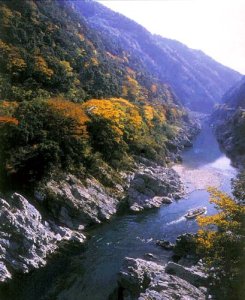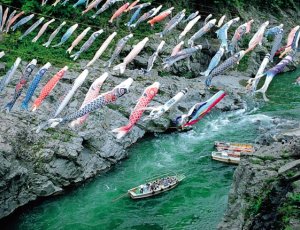|
Welcome to Tokushima!!

|
||
|
Tokushima is located at the east side of Shikoku which consists of four prefectures. Shikoku is connected to the mainland (Honshu) with three bridges. Tokushima is also accessible by air from the major cities in Japan. The warm climate, fertile soil, and beautiful ocean of Tokushima, combined with its history and culture, give rise to its citizens' warm hospitality. |
||
| Tokushima City | ||
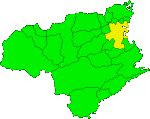
Tokushima City, the capital of Tokushima Pref., has many sightseeing spots. Mt. Bizan, castle ruin, a historical museum, Awa Dance Museum and etc.. Yoshino river is very large famous and large river in Japan, and many branches are running through the center of the city. |
||
 Yoshino River Bridge |
 The Night View From Bizan The green hill near Tokushima Station is called Bizan ( Mt. Bi ). This peak atop Bizan is filled with greenery and flowers in every season. There are many temples and shrines around Bizan. Visiting them along the historical street will be fine. |
| With a history dating back over 400 years, the Awa Odori dance festival is Tokushima's largest event. Today, many other regions outside Tokushima hold their own version of the Awa Odori, and its dancers have even been invited to events overseas. Awa Odori as the main events of traditional summer festival held around mid-August. The most famous is the Tokushima City Awa Odori held for four days form August 12th to 15th, when more than 1.3 million participants and spectators transform central Tokushima into a teeming mass of excitement. Waving hands and shuffling feet, dancers join the dance procession. Many tourists also join, driven by the thundering two-beat pulse, color, sound, movement and energy of Awa Odori. On the 2nd floor of Awa Odori Library (Awa Odori Kaikan), you can see Awa Dance and dance with a Ren (dancing group) all year round. On the fifth floor is the rope-way station that leads to the top of Mt. Bizan, the symbol of Tokushima. |
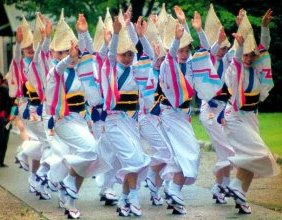 Awa Odori Dance Carnival  Awa Odori Kaikan
Awa Odori Kaikan
|
| Naruto City | |

Naruto City is synonymous with whirlpools. The Seto inland and Kii Channel meet at Naruto Straits, between Naruto and Awaji island. At this point the tidal difference is 1.3 meters and the speed of the current is 15-20 kph, generating many large and small whirlpools, some as big as 20 meters in diameter. The result is one of the world's major eddying currents, an awesome display of the forces of nature. |
|
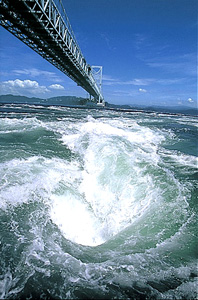 Naruto Whirlpools |
A walkway " Uzu-no-michi" is
on the lower part of Onaruto Bridge. You can see the fascinating whirlpools through the glassed
floor from 45m above the sea.
Entrance fee Adult 500 yen, Child (13-18 years old) 400 yen, Child (under 12) 250 yen. Open from 9:30 to 17:30. Closed on Monday. The whirlpools are magnificent when seen from high above, but when you ride into the boat, you can feel their power at close range and the thrill is even greater! The boat at that allows underwater viewing is also very popular. The time of the whirls are most spectacular is when the moon is full or new, especially in spring or autumn. |
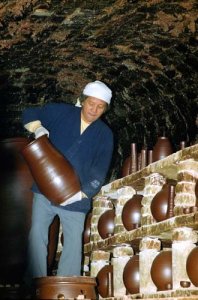 Traditional Otani Pottery |
This style of pottery was begun in 1780 by the master Bun'emon,
who used red clay from the village of Otani.
The simplicity of the pottery utilizes the unique properties of the clay, and is fired in a tall "nobori-gama" kiln, known as the best of its kind in Japan. Recently, various original artistic works are being produced. Otani yaki is designed for daily use and a wide variety of pottery is available. To knead clay and mold cups or plates, visit the Otaniyaki-no-sato. An appointment is necessary. 30 minutes from Tokushima Station by car. |
|
The Shikoku Pilgrimage is the most famous and popular pilgrimage in Japan.
About 1200 years ago, the Buddhist priest Kukai founded this pilgrimage as a form of spiritual training. There are four sections : Awa, Tosa, Iyo, and Sanuki. Many people walk the circuit of the 88 temples. Of the 88 temples, Tokushima Prefecture contains from first temple (Ryouzenji) to 23th temple (Yakuouji) and 66th (Unpenji). The number 88 represents the number of evil passions identified by Buddhist doctrine, and ideally it is believed that one can get rid of all evil passions by visiting each of the 88 temples. Recently, People make a pilgrimage to a desire to pray for coming true or to stare at oneself again. 30 minutes from Tokushima Station by car. |
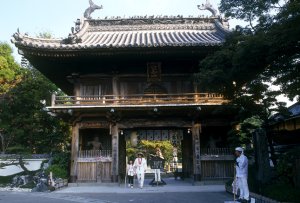 Ryozenji-Temple (First Pilgrimage Temple) |
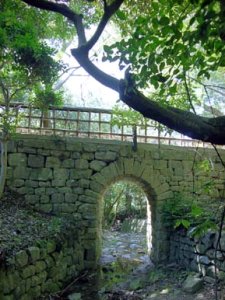
German Bridge |
German prisoners during World War I were interned in Naruto.
The German Bridge built by prisoners and the German Park are nearby.
The German Bridge is located in Oasahiko shrine. It is 10 minutes from German House. The prisoners socialized relatively freely with the local people and left many signs of German culture behind. The present-day, German House was newly built in 1993. Recently, a German-village named Baruto-no-Gakuen" has been opened. 35 minutes from Tokushima Station by car. |
| Near Tokushima City | |
|
"Awa and indigo, indigo and Awa".
The two have been intimately associated for generations.
The medieval lord Hachisuka Iemasa recognized the suitability of the Yoshino river area for producing Awa indigo and so he protected and promoted the industry, which led to its later development. This house, preserved from the days when Awa indigo dyeing flourished, presents all of the tools of the trade for display. You can even try indigo dyeing for yourself. |
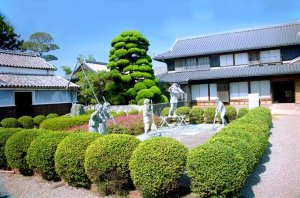 Ai-no-Yakata |
| Iya Valley | ||
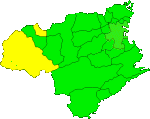

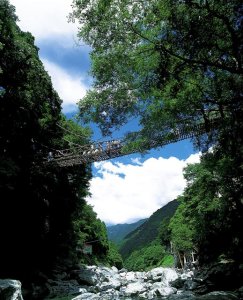
Iya Vine Bridge In ancient times, people built many of these vine bridges for regular use with vines that grew wild in the mountains, but few remain today. Looking down will give anyone butterflies in the stomach. This is one of the three unusual bridges in Japan. A walk on the bridge (500 yen) takes you back in that time. 2 hours from Tokushima Station by car. |
||
|
These gorge have beautiful landscape. Yoshino river cuts through the mountains of Shikoku, and makes these gorge with its myriad shapes and forms. The boat tour will attract you with various scenes. A 30 minute cruise around Oboke valley starts at the landing-stage. Please enjoy magnificent nature. Rafting (from May to October) is popular among young people. There are a lot of hot springs near here, too. 90 minutes from Tokushima Station by car. 15 minutes from Oboke Station by walk. |
||
| West Area | ||
Mt Tsurugi was specified for the quasi-national park. Mt. Tsurugi is named
this name from the legend that "Antoku Emperor" buried a treasure
sword in the ground. Second to Mt.Ishizuchi, this is the next highest mountain
in western Japan at 1955 meters. On a clear day one can see Muroto Cape,
the Kii Peninsula, and Okayama from the peak.

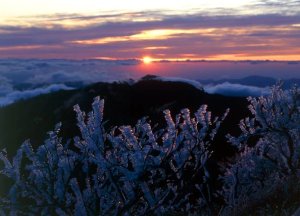 The View at the Summit of Mt. Tsurugi. Chair lift service is available from April to November. Chair lifts take about 15 minutes. You can walk to the mountain top from near Minokoshi Station. 2.5 hours from JR Tokushima Station by car. |
||
|
The clear stream in Yoshino river hits rocks of fantastic shape,
the rocks become gradual. This spectacle has been compared
to the world of the Indian-ink drawing from old.
The name is given to each rock by the shape and history, "lion dance rock", "carp fishing rock", "Eel rolling rock", etc. 1hour from Tokushima Station by car. |
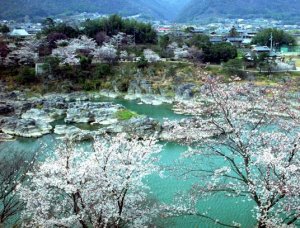 Minoda-no-Fuchi |

Shiozuka-Plateau |
The highest point is Shiozuka Peak at 1,413 meters, and the heights consist of
about 100 hectares of meadows stretching across Tokushima and Ehime prefectures.
People can enjoy nature here all year round, at the many athletic and outdoor facilities
that also include a hang-gliding area.
Moreover, it is popular as the base of para glider. 2 hours from Tokushima Station by car. |
| South Area | |
 Kitanowaki-Beach |
Kitanowaki beach has shallow beach and wide sands and vast pine-covered area.
The young person and the family gather in here at the season of sea bathing.
It boasts of "Beautiful water". This beach is always the highest rank
in the water survey executed every year.
Open : July 1 - August 20 40 minutes from Tokushima Station by car. |
| Middle area | |
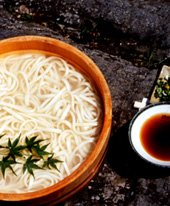 Tarai-Udon |
This is hand-made noodle, it puts in a wooden tub. The peculiar flavor neatly made is a boast.
Eating while looking at the valley beauty in summer is also good. 35 minutes from Tokushima Station by car. |
|
A natural work of art in soil, formed over 200 million years of erosion.
At night it is lit and its beauty seems otherworldly.
The big one is ten meters or more in height.
40 minutes from Tokushima Station by car. |
 Earth Pillars (Dochu) |
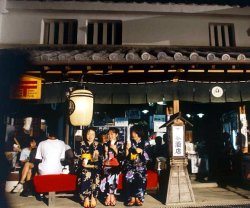 Historic street of Udatsu |
"Udatsu" refers to the roof extensions used as wing walls
in the Edo period to protect wooden
roofs and prevent fires using a clay-type soil. Wakimachi was the
heart of the indigo dyeing district and home to many wealthy merchants, so many large houses that use
authentic roofing tiles and include an old-fashioned Japanese stoerhouse can be found
here. The national government has designated this
area a preservation district for its important traditional architecture.
40 minutes from Tokushima Station by car. |
|
Top Page NDES'07 Web Site |
|
